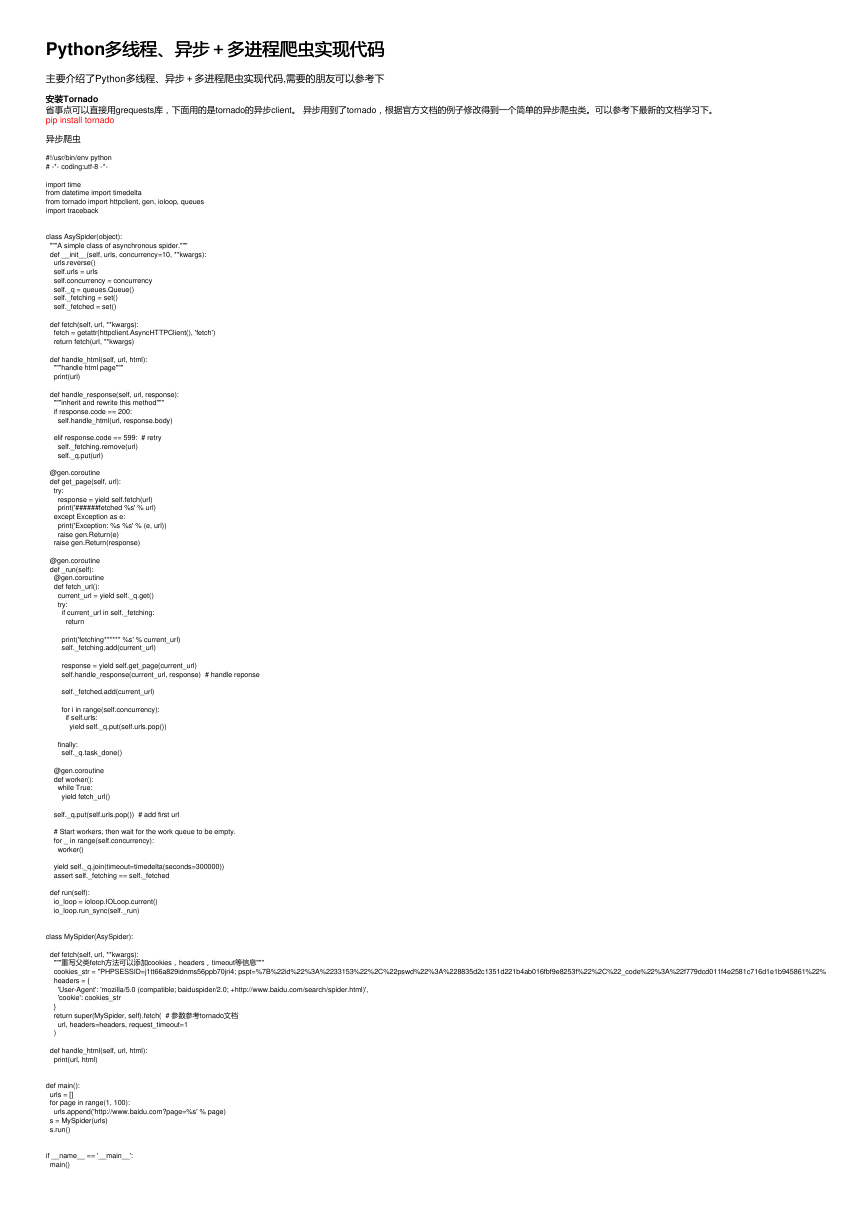Python多线程、异步+多进程爬虫实现代码
多线程、异步+多进程爬虫实现代码
主要介绍了Python多线程、异步+多进程爬虫实现代码,需要的朋友可以参考下
安装安装Tornado
省事点可以直接用grequests库,下面用的是tornado的异步client。 异步用到了tornado,根据官方文档的例子修改得到一个简单的异步爬虫类。可以参考下最新的文档学习下。
pip install tornado
异步爬虫
#!/usr/bin/env python
# -*- coding:utf-8 -*-
import time
from datetime import timedelta
from tornado import httpclient, gen, ioloop, queues
import traceback
class AsySpider(object):
"""A simple class of asynchronous spider."""
def __init__(self, urls, concurrency=10, **kwargs):
urls.reverse()
self.urls = urls
self.concurrency = concurrency
self._q = queues.Queue()
self._fetching = set()
self._fetched = set()
def fetch(self, url, **kwargs):
fetch = getattr(httpclient.AsyncHTTPClient(), 'fetch')
return fetch(url, **kwargs)
def handle_html(self, url, html):
"""handle html page"""
print(url)
def handle_response(self, url, response):
"""inherit and rewrite this method"""
if response.code == 200:
self.handle_html(url, response.body)
elif response.code == 599: # retry
self._fetching.remove(url)
self._q.put(url)
@gen.coroutine
def get_page(self, url):
try:
response = yield self.fetch(url)
print('######fetched %s' % url)
except Exception as e:
print('Exception: %s %s' % (e, url))
raise gen.Return(e)
raise gen.Return(response)
@gen.coroutine
def _run(self):
@gen.coroutine
def fetch_url():
current_url = yield self._q.get()
try:
if current_url in self._fetching:
return
print('fetching****** %s' % current_url)
self._fetching.add(current_url)
response = yield self.get_page(current_url)
self.handle_response(current_url, response) # handle reponse
self._fetched.add(current_url)
for i in range(self.concurrency):
if self.urls:
yield self._q.put(self.urls.pop())
finally:
self._q.task_done()
@gen.coroutine
def worker():
while True:
yield fetch_url()
self._q.put(self.urls.pop()) # add first url
# Start workers, then wait for the work queue to be empty.
for _ in range(self.concurrency):
worker()
yield self._q.join(timeout=timedelta(seconds=300000))
assert self._fetching == self._fetched
def run(self):
io_loop = ioloop.IOLoop.current()
io_loop.run_sync(self._run)
class MySpider(AsySpider):
def fetch(self, url, **kwargs):
"""重写父类fetch方法可以添加cookies,headers,timeout等信息"""
cookies_str = "PHPSESSID=j1tt66a829idnms56ppb70jri4; pspt=%7B%22id%22%3A%2233153%22%2C%22pswd%22%3A%228835d2c1351d221b4ab016fbf9e8253f%22%2C%22_code%22%3A%22f779dcd011f4e2581c716d1e1b945861%22%7D; key=%E9%87%8D%E5%BA%86%E5%95%84%E6%9C%A8%E9%B8%9F%E7%BD%91%E7%BB%9C%E7%A7%91%E6%8A%80%E6%9C%89%E9%99%90%E5%85%AC%E5%8F%B8; think_language=zh-cn; SERVERID=a66d7d08fa1c8b2e37dbdc6ffff82d9e|1444973193|1444967835; CNZZDATA1254842228=1433864393-1442810831-%7C1444972138" # 从浏览器拷贝cookie字符串
headers = {
'User-Agent': 'mozilla/5.0 (compatible; baiduspider/2.0; +http://www.baidu.com/search/spider.html)',
'cookie': cookies_str
}
return super(MySpider, self).fetch( # 参数参考tornado文档
url, headers=headers, request_timeout=1
)
def handle_html(self, url, html):
print(url, html)
def main():
urls = []
for page in range(1, 100):
urls.append('http://www.baidu.com?page=%s' % page)
s = MySpider(urls)
s.run()
if __name__ == '__main__':
main()
�
可以继承这个类,塞一些url进去,然后重写handle_page处理得到的页面。
异步+多进程爬虫
还可以再变态点,加个进程池,使用了multiprocessing模块。效率飕飕的,
#!/usr/bin/env python
# -*- coding:utf-8 -*-
import time
from multiprocessing import Pool
from datetime import timedelta
from tornado import httpclient, gen, ioloop, queues
class AsySpider(object):
"""A simple class of asynchronous spider."""
def __init__(self, urls, concurrency):
urls.reverse()
self.urls = urls
self.concurrency = concurrency
self._q = queues.Queue()
self._fetching = set()
self._fetched = set()
def handle_page(self, url, html):
filename = url.rsplit('/', 1)[1]
with open(filename, 'w+') as f:
f.write(html)
@gen.coroutine
def get_page(self, url):
try:
response = yield httpclient.AsyncHTTPClient().fetch(url)
print('######fetched %s' % url)
except Exception as e:
print('Exception: %s %s' % (e, url))
raise gen.Return('')
raise gen.Return(response.body)
@gen.coroutine
def _run(self):
@gen.coroutine
def fetch_url():
current_url = yield self._q.get()
try:
if current_url in self._fetching:
return
print('fetching****** %s' % current_url)
self._fetching.add(current_url)
html = yield self.get_page(current_url)
self._fetched.add(current_url)
self.handle_page(current_url, html)
for i in range(self.concurrency):
if self.urls:
yield self._q.put(self.urls.pop())
finally:
self._q.task_done()
@gen.coroutine
def worker():
while True:
yield fetch_url()
self._q.put(self.urls.pop())
# Start workers, then wait for the work queue to be empty.
for _ in range(self.concurrency):
worker()
yield self._q.join(timeout=timedelta(seconds=300000))
assert self._fetching == self._fetched
def run(self):
io_loop = ioloop.IOLoop.current()
io_loop.run_sync(self._run)
def run_spider(beg, end):
urls = []
for page in range(beg, end):
urls.append('http://127.0.0.1/%s.htm' % page)
s = AsySpider(urls, 10)
s.run()
def main():
_st = time.time()
p = Pool()
all_num = 73000
num = 4 # number of cpu cores
per_num, left = divmod(all_num, num)
s = range(0, all_num, per_num)
res = []
for i in range(len(s)-1):
res.append((s[i], s[i+1]))
res.append((s[len(s)-1], all_num))
print res
for i in res:
p.apply_async(run_spider, args=(i[0], i[1],))
p.close()
p.join()
print time.time()-_st
if __name__ == '__main__':
main()
多线程爬虫
线程池实现.
#!/usr/bin/env python
# -*- coding:utf-8 -*-
import Queue
import sys
import requests
import os
import threading
import time
class Worker(threading.Thread): # 处理工作请求
def __init__(self, workQueue, resultQueue, **kwds):
threading.Thread.__init__(self, **kwds)
self.setDaemon(True)
self.workQueue = workQueue
�
self.resultQueue = resultQueue
def run(self):
while 1:
try:
callable, args, kwds = self.workQueue.get(False) # get task
res = callable(*args, **kwds)
self.resultQueue.put(res) # put result
except Queue.Empty:
break
class WorkManager: # 线程池管理,创建
def __init__(self, num_of_workers=10):
self.workQueue = Queue.Queue() # 请求队列
self.resultQueue = Queue.Queue() # 输出结果的队列
self.workers = []
self._recruitThreads(num_of_workers)
def _recruitThreads(self, num_of_workers):
for i in range(num_of_workers):
worker = Worker(self.workQueue, self.resultQueue) # 创建工作线程
self.workers.append(worker) # 加入到线程队列
def start(self):
for w in self.workers:
w.start()
def wait_for_complete(self):
while len(self.workers):
worker = self.workers.pop() # 从池中取出一个线程处理请求
worker.join()
if worker.isAlive() and not self.workQueue.empty():
self.workers.append(worker) # 重新加入线程池中
print 'All jobs were complete.'
def add_job(self, callable, *args, **kwds):
self.workQueue.put((callable, args, kwds)) # 向工作队列中加入请求
def get_result(self, *args, **kwds):
return self.resultQueue.get(*args, **kwds)
def download_file(url):
#print 'beg download', url
requests.get(url).text
def main():
try:
num_of_threads = int(sys.argv[1])
except:
num_of_threads = 10
_st = time.time()
wm = WorkManager(num_of_threads)
print num_of_threads
urls = ['http://www.baidu.com'] * 1000
for i in urls:
wm.add_job(download_file, i)
wm.start()
wm.wait_for_complete()
print time.time() - _st
if __name__ == '__main__':
main()
这三种随便一种都有很高的效率,但是这么跑会给网站服务器不小的压力,尤其是小站点,还是有点节操为好。
�






 2023年江西萍乡中考道德与法治真题及答案.doc
2023年江西萍乡中考道德与法治真题及答案.doc 2012年重庆南川中考生物真题及答案.doc
2012年重庆南川中考生物真题及答案.doc 2013年江西师范大学地理学综合及文艺理论基础考研真题.doc
2013年江西师范大学地理学综合及文艺理论基础考研真题.doc 2020年四川甘孜小升初语文真题及答案I卷.doc
2020年四川甘孜小升初语文真题及答案I卷.doc 2020年注册岩土工程师专业基础考试真题及答案.doc
2020年注册岩土工程师专业基础考试真题及答案.doc 2023-2024学年福建省厦门市九年级上学期数学月考试题及答案.doc
2023-2024学年福建省厦门市九年级上学期数学月考试题及答案.doc 2021-2022学年辽宁省沈阳市大东区九年级上学期语文期末试题及答案.doc
2021-2022学年辽宁省沈阳市大东区九年级上学期语文期末试题及答案.doc 2022-2023学年北京东城区初三第一学期物理期末试卷及答案.doc
2022-2023学年北京东城区初三第一学期物理期末试卷及答案.doc 2018上半年江西教师资格初中地理学科知识与教学能力真题及答案.doc
2018上半年江西教师资格初中地理学科知识与教学能力真题及答案.doc 2012年河北国家公务员申论考试真题及答案-省级.doc
2012年河北国家公务员申论考试真题及答案-省级.doc 2020-2021学年江苏省扬州市江都区邵樊片九年级上学期数学第一次质量检测试题及答案.doc
2020-2021学年江苏省扬州市江都区邵樊片九年级上学期数学第一次质量检测试题及答案.doc 2022下半年黑龙江教师资格证中学综合素质真题及答案.doc
2022下半年黑龙江教师资格证中学综合素质真题及答案.doc